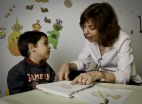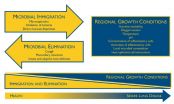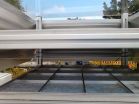Scientists achieve major breakthrough in thin-film magnetism
2015-08-17
(Press-News.org) Magnetism in nanoscale layers only a few tens of atoms thick is one of the foundations of the big data revolution - for example, all the information we download from the internet is stored magnetically on hard disks in server farms dotted across the World. Recent work by a team of scientists working in Singapore, The Netherlands, USA and Ireland, published on 14 August 2015 in the prestigious journal, Science, has uncovered a new twist to the story of thin-film magnetism.
The team from the National University of Singapore (NUS) - Mr Li Changjian, a graduate student from the NUS Graduate School for Integrative Sciences and Engineering, Assistant Professor Ariando and Professor T Venky Venkatesan - led to the discovery of this new magnetic phenomenon by growing perfectly-crystalline atomic layers of a manganite, an oxide of lanthanum and manganese {LaMnO3}, on a substrate crystal of nonmagnetic strontium titanate using a method - pulsed laser deposition - developed many years ago for high-temperature superconductors and multicomponent materials by Prof Venkatesan, who now heads the NUS Nanoscience and Nanotechnology Institute (NUSNNI).
The manganite is an antiferromagnet when it is atomically thin and shows no magnetism. The new discovery is that its magnetism is switched on abruptly when the number of Manganese atomic layers changes from 5 to 6 or more. The conjecture is that this arises from an avalanche of electrons from the top surface of the film to the bottom, where the electrons are confined near the substrate. This shift of electric charge occurs as the manganese atomic layers form atomically charged capacitors leading to the build-up of an electric field, known as 'polar catastrophe', inside the manganite. As a consequence of this charge transfer, the manganite layer switches to a strongly ferromagnetic state, as could be visualised by a magnetic microscopy technique called Scanning SQUID Microscopy. This was conducted by Dr Xiao Renshaw Wang, who is a PhD graduate from NUSNNI, working with Professor Hans Hilgenkamp at the MESA+ Institute of the University of Twente in The Netherlands. The work validates the polar catastrophe model, and it shows how the addition of just one extra atomic layer can transform the magnetism.
The team plans to use local electric fields to controllably turn on/off the magnetism of its 5-layer films, and explore potential applications in microwave devices and magnetic recording. With magnetic memory elements approaching nano dimensions, this technique promises new approaches in magnetic recording and computing.
INFORMATION:
ELSE PRESS RELEASES FROM THIS DATE:
2015-08-17
Bilingual children pose unique challenges for clinicians, and, until recently, there was little research on young bilinguals to guide clinical practice. In the past decade, however, research on bilingual development has burgeoned, and the scientific literature now supports several conclusions that should help clinicians as they assess bilingual children and advise their parents.
In an article recently published in Seminars in Speech and Language, Erika Hoff, Ph.D., a professor of psychology in the Charles E. Schmidt College of Science at Florida Atlantic University, ...
2015-08-17
ANN ARBOR, Mich. - One of the most common complaints about hospitals is the noise. Patients complain that they can't sleep soundly in the environment of multiple monitors, paging systems, wheelchairs and gurneys, and carts that squeak.
Ongoing efforts at the University of Michigan Health System are making the hospital quieter, and the hospital has tested sound panels designed to dial down noise.
During a pilot study, strategically placed sound acoustic panels helped diffuse sound in the hallways around patient rooms. The modest 3-4 sound decibel drop is recognizable ...
2015-08-17
When researchers dream about electronics of the future, they more or less dream of pouring liquids into a beaker, stirring them together and decanting a computer out onto the table. This field of research is known as self-assembling molecular electronics. But, getting chemical substances to self-assemble into electronic components is just as complicated as it sounds. Now, a group of researchers has published their breakthrough within the field. The group consists of first-year nanoscience students from the University of Copenhagen.
Thomas Just Sørensen, an associate ...
2015-08-17
This news release is available in German. Two growth-promoting groups of substances, or phytohormones, the gibberellins and the brassinosteroids, are used independently of each other for the breeding and production of crop plants. A team of scientists at Technical University of Munich (TUM) has now discovered that the two act in concert - without brassinosteroids, a plant is unable to produce gibberellins.
For their current investigations, a research group at the Technical University of Munich, supported by scientists from the Helmholtz Zentrum Munich and the TU Braunschweig ...
2015-08-17
ANN ARBOR, Mich. -- With every breath you take, microbes have a chance of making it into your lungs. But what happens when they get there? And why do dangerous lung infections like pneumonia happen in some people, but not others?
Researchers at the University of Michigan Medical School have started to answer these questions by studying the microbiome of the lungs - the community of microscopic organisms are in constant contact with our respiratory system.
By studying these bacterial communities, and how they change in illness, they hope to pave the way for new ways ...
2015-08-17
Troubling questions about multiracial congregations' potential to address racial inequality are raised by a new national study done by researchers at Baylor University, the University of Southern California and the University of Chicago.
The study -- "United by Faith? Race/Ethnicity, Congregational Diversity, and Explanations of Racial Inequality" -- is published in the journal Sociology of Religion.
"We find little evidence that multiracial congregations promote progressive racial views among attendees of any race or ethnicity," the researchers wrote. Views of minorities ...
2015-08-17
BOSTON, Aug. 17, 2015 --Native North Americans have long adorned themselves and their homes with fragrant sweetgrass (Hierochloe odorata), a native plant used in traditional medicine, to repel biting insects, and mosquitoes in particular. Now, researchers report that they have identified the compounds in sweetgrass that keep these bugs at bay.
The team will describe their approach in one of more than 9,000 presentations at the 250th National Meeting & Exposition of the American Chemical Society (ACS), the world's largest scientific society, taking place here through Thursday.
Mosquitoes ...
2015-08-17
BOSTON, Aug. 17, 2015 -- Hand-written letters and printed photos seem quaint in today's digital age. But there's one thing that traditional media have over hard drives: longevity. To address this modern shortcoming, scientists are turning to DNA to save unprecedented amounts of digital data for posterity. One team has demonstrated that DNA they encapsulated can preserve information for at least 2,000 years, and they're now working on a filing system to make it easier to navigate.
The researchers present their work today at the 250th National Meeting & Exposition of the ...
2015-08-17
BOSTON, Aug. 17, 2015 -- A blood clot is a dangerous health situation with the potential to trigger heart attacks, strokes and other medical emergencies. To treat a blood clot, doctors need to find its exact location. But current clinical techniques can only look at one part of the body at a time, slowing treatment and increasing the risk for complications. Now, researchers are reporting a method, tested in rats, that may someday allow health care providers to quickly scan the entire body for a blood clot.
The team will describe their approach in one of more than 9,000 ...
2015-08-17
BOSTON, Aug.17, 2015 -- In a first-of-its-kind study, researchers have determined that natural sunlight triggers the release of smog-forming nitrogen oxide compounds from the grime that typically coats buildings, statues and other outdoor surfaces in urban areas. The finding confirms previous laboratory work using simulated sunlight and upends the long-held notion that nitrates in urban grime are "locked" in place.
The scientists will present their findings based on field studies conducted in Leipzig, Germany, and Toronto, Canada, at the 250th National Meeting & Exposition ...
LAST 30 PRESS RELEASES:
[Press-News.org] Scientists achieve major breakthrough in thin-film magnetism





